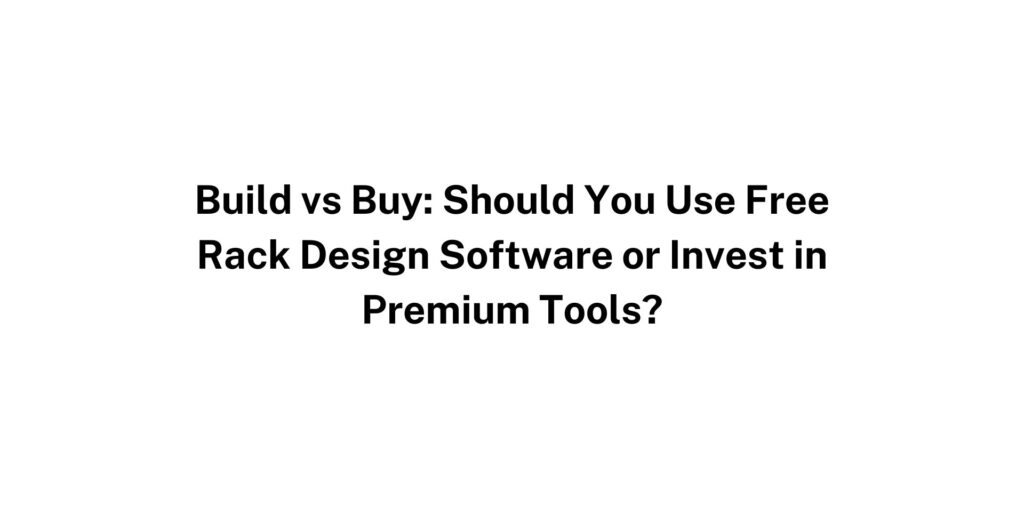The question of build versus buy is a classic dilemma in any field—whether you’re configuring servers, creating software, or planning AV racks. For audio-visual engineers, IT professionals, or anyone managing structured cabling and hardware installations, the decision becomes even more relevant when considering which rack design software to use.
Do you go with a free rack design software option that gets the job done with limited features, or invest in a premium tool with advanced capabilities? Is it more cost-effective to use a DIY, open-source solution, or is there a clear return on investment when choosing a commercial software package?
This blog will explore the pros and cons of both approaches, using real-world examples and expert insights. We’ll help you determine which path is right for you based on factors like project scale, technical expertise, collaboration needs, and budget.
Understanding Rack Design Software and Its Purpose
Before comparing free and premium options, it’s important to understand the core functions of rack design software:
-
Rack Layout Planning: Placing and organizing AV or IT equipment like servers, switches, patch panels, amplifiers, etc.
-
Cable Management: Designing signal and power cable routes and labeling paths.
-
Thermal and Power Load Balancing: Ensuring equipment operates within environmental and electrical limits.
-
Documentation Generation: Creating detailed reports, schematics, and diagrams for installation and maintenance.
Good rack design software acts as a blueprint and simulation platform, helping engineers avoid critical mistakes in live environments and standardizing installations across sites.
The Case for Free Rack Design Software
Pros
1. Cost-Efficiency
Free software eliminates upfront costs, licensing fees, and subscription renewals—ideal for startups, freelance engineers, or educational institutions.
2. Accessibility
Most free tools are web-based or lightweight desktop apps. No long procurement cycles or hardware requirements.
3. Simplicity
Many free tools offer basic drag-and-drop interfaces, making them beginner-friendly and ideal for learning.
4. Open Source Flexibility
With open-source rack design tools, users can tweak source code or integrate plugins based on custom workflows.
Popular Free Rack Design Software Options
-
Network Notepad – A simple visual editor for network equipment layouts.
-
LibreCAD or QCAD – General-purpose CAD software adapted for AV/IT use.
-
RackTables – Asset management and rack layout for small to medium networks.
-
Visio with AV templates – While Visio isn’t free, many AV designers use it with free stencils and templates.
Limitations
1. Limited Equipment Libraries
You may not have access to a rich database of manufacturer-verified models or updated equipment footprints.
2. Lack of Simulation Features
Free rack design software often lacks environmental simulations for airflow, load balancing, or power consumption.
3. Manual Documentation
Report generation and cable labeling may need to be done manually or using external tools.
4. No Real-Time Collaboration
Most free tools are designed for single-user access, limiting their use in teams or large firms.
Why Go Premium? The Power of Paid Rack Design Software
Premium Software Advantages
1. Complete Design Ecosystem
Paid solutions offer end-to-end integration—rack layout, wiring diagrams, power calculation, inventory management, and BIM export—all within one platform.
2. Verified Equipment Libraries
Access thousands of up-to-date models from top manufacturers like Cisco, Crestron, Extron, Middle Atlantic, and more.
3. Advanced Cable Management
Premium rack design software auto-generates wiring paths with signal flow direction, labeling, and color-coding.
4. Real-Time Collaboration
Teams can work simultaneously on cloud-based models, enabling global design and faster project delivery.
5. Professional Documentation
Generate ready-to-submit documents, cut sheets, and reports with one click—no formatting headaches.
6. Integration with Other Platforms
Seamless sync with AutoCAD, Revit, BIM 360, AV project management software, and ERPs.
Top Paid Tools
-
XTEN-AV – Cloud-based AI-powered platform for AV rack design, documentation, and real-time collaboration.
-
D-Tools System Integrator – Popular in AV design-build workflows with project budgeting and quoting.
-
AutoCAD Electrical – General-purpose CAD with electrical schematics, often paired with rack design plug-ins.
-
EPLAN – High-end engineering tool for complex control cabinets and industrial AV.
Comparing Key Features – Free vs Premium
| Feature | Free Rack Design Software | Premium Rack Design Software |
|---|---|---|
| Equipment Libraries | Limited or community-contributed | Manufacturer-certified, extensive |
| Cable Management | Manual | Automated with labeling & reports |
| Real-Time Collaboration | Rare | Common with cloud-based platforms |
| Document Generation | Export image/PDF only | Auto-generated reports & BOMs |
| Environmental Simulation | Not available | Thermal, electrical, structural |
| Project Templates | Basic or user-made | Professional-grade, reusable |
| Technical Support | Community forums | Dedicated support teams |
| Licensing Costs | Free | Subscription or per-license fee |
Evaluating Based on Use Cases
Scenario 1: Freelance AV Designer
-
Need: Build basic rack layouts, create signal path diagrams, and share visuals with small clients.
-
Recommendation: Free tools like Visio (with free AV templates) or RackTables may suffice.
Scenario 2: Large AV Integration Firm
-
Need: Deliver multi-room designs, synchronize with BIM, and generate rack drawings for commercial clients.
-
Recommendation: Invest in XTEN-AV or D-Tools for integrated workflows, speed, and accuracy.
Scenario 3: IT Department in Higher Education
-
Need: Manage server racks across campuses, coordinate with cabling vendors, and maintain change history.
-
Recommendation: Combine a free asset management tool like RackTables with a mid-tier premium design tool.
Total Cost of Ownership (TCO)
It’s easy to assume that free tools always save money. But the real cost of software includes:
-
Time Spent on Manual Tasks: Drawing cables manually, formatting documentation, and verifying compatibility.
-
Training Time: Learning multiple disconnected tools instead of one integrated solution.
-
Error Costs: Incorrect rack plans can lead to installation delays, equipment damage, or compliance issues.
Premium tools may have a higher upfront cost, but they often pay for themselves by:
-
Reducing rework and site visits.
-
Accelerating project timelines.
-
Enhancing client satisfaction with polished deliverables.
Making the Decision – A Strategic Checklist
Ask yourself the following:
What’s the scale and frequency of your projects?
If you’re designing racks daily or weekly, a premium tool will save hours per project.
Do you collaborate with others?
Cloud-based rack design software with real-time collaboration is essential for distributed teams.
What’s your documentation requirement?
If your work must pass audits, meet compliance, or be used for permitting, premium tools are worth it.
How tech-savvy is your team?
Free tools may require more training or workaround. Premium tools come with support and tutorials.
Are you looking long-term?
As your firm grows, a premium solution offers scalability, integration, and efficiency you’ll eventually need.
Hybrid Strategies – The Best of Both Worlds
Some teams start with free rack design software and switch to premium once they scale. Others use a hybrid strategy:
-
Use free tools for concepting and drafts
-
Use premium platforms for final delivery and documentation
For example:
-
Create a draft rack in Visio or EasyEDA.
-
Export the layout and import it into XTEN-AV or D-Tools for final schematics and cable planning.
This strategy minimizes upfront cost while building toward professional output.
Conclusion
There’s no universal answer to the build vs buy debate when it comes to rack design software. It depends on your project scale, budget, team structure, and long-term goals.
-
Choose free rack design software if you’re getting started, working on small-scale projects, or need a low-cost solution for drafts.
-
Invest in premium tools if accuracy, speed, documentation, collaboration, and manufacturer integrations matter to your business.
In both cases, the goal is the same—build reliable, optimized, and scalable racks that meet performance, compliance, and aesthetic expectations.




